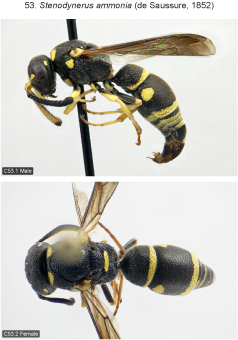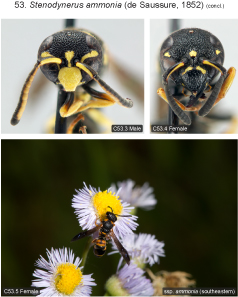
| Home | Table of contents | Keys | Species list | Glossary | Image data | PDF | Cite this article | Feedback | Updates |
Identification Atlas of the Vespidae (Hymenoptera, Aculeata) of the northeastern Nearctic region
CJAI 05, February 19, 2008
doi: 10.3752/cjai.2008.05
Matthias Buck, Stephen A. Marshall, and David K.B. Cheung
Department of Environmental Biology, University of Guelph, Guelph, Ontario, Canada N1G 2W1
Next species | Previous species | Key
53. Stenodynerus ammonia (de Saussure, 1852)
Figs B2.34; B7.21–23, 25, 62; C53.1–5.

|

|
Species recognition. This species and S. anormis are the only representatives of the S. anormis-group in our area. The group is characterized by the apically truncate (not emarginate) clypeus and the deformed male mid femur (the latter occurs also in S. fundatiformis). The two species can be separated by the characters given in the key. The clypeus of female S. oculeus is often truncate as well but this species possesses distinct interocellar tubercles (including an eyelid-like swelling behind mid ocellus), lacks the irregular transverse carina of near the summit of tergum 1 and the discal spots of tergum 1 (present only in S. ammonia specimens from southeastern U.S.).
Variation. Fore wing length 5.0–6.0 mm (♂♂), 5.5–7.0 mm (♀♀). Female clypeus with a yellow crescent-shaped dorsal mark often interrupted medially, rarely reduced to a pair of small spots. Interantennal spot usually restricted to area above interantennal prominence, sometimes extending to clypeus in male. Postocular spot sometimes small, rarely completely absent. Pronotal spots usually less than twice as wide as long, occasionally about three times as wide as long. Parategula usually black, occasionally marked with yellow, rarely completely yellow. Propodeum in female sometimes with a pair of small ventrolateral spots, rarely extending further up and extending to propodeal angle. Female terga 1–4 and male terga 1–6 with apical fasciae, the fascia of tergum 3 complete or interrupted medially, rarely reduced to small spots. Sternum 2 with apical fascia, sometimes interrupted medially and/or laterally (more often in female than in male); sternum 3 usually with apicolateral spots, rarely missing in female, sometimes with a complete fascia in male and then sternum 4 with apicolateral spots as well.
Distribution. Canada: newly recorded for ON and MB. Eastern U.S. west to MN, KS and TX (Krombein 1979). Reddish-marked populations from SC to FL represent the nominate subspecies. The widespread yellow form is ssp. paraensis (de Saussure, 1855).
Biology. Unknown. The biological information provided for S. ammonia ammonia by Krombein (1967) is probably based on a misidentification and was not included in Krombein (1979). The taxon Krombein (1967) referred to as S. ammonia histrionalis is in fact S. histrionalis (see Krombein 1979).
Next species | Previous species | Key
| Home | Table of contents | Keys | Species list | Glossary | Image data | PDF | Cite this article | Feedback | Updates |
